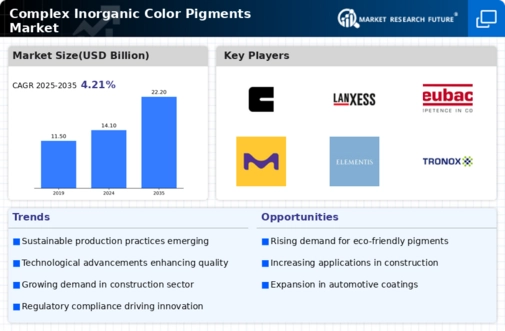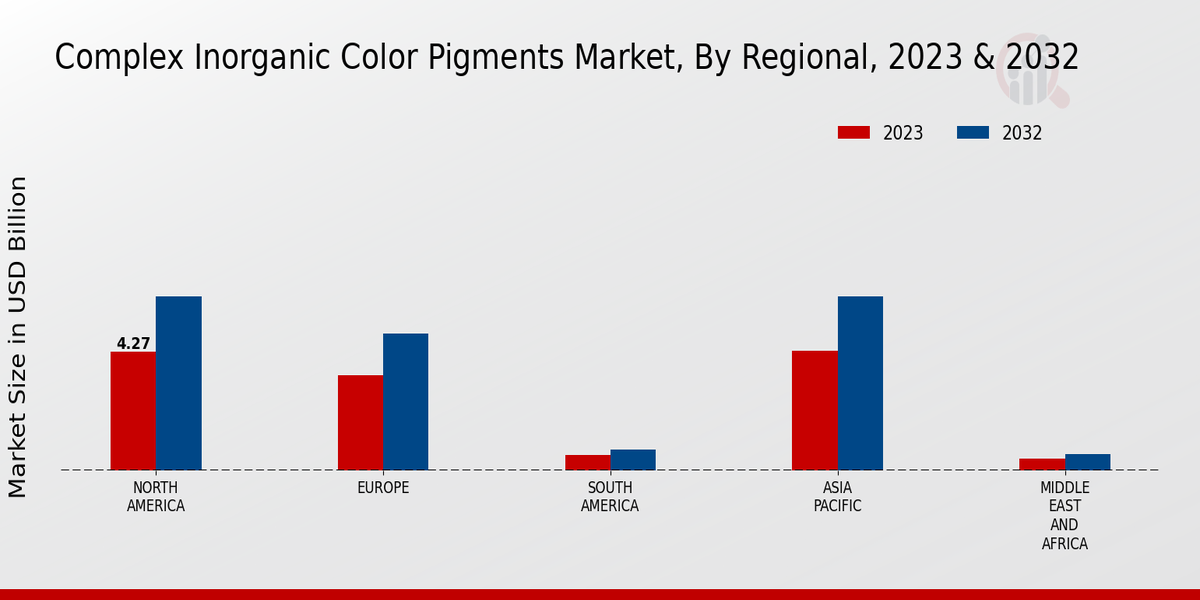Market Growth Projections
The Global Complex Inorganic Color Pigments Market Industry is poised for substantial growth, with projections indicating a market size of 14.1 USD Billion in 2024 and an anticipated increase to 22.2 USD Billion by 2035. This growth trajectory suggests a compound annual growth rate (CAGR) of 4.21% from 2025 to 2035. Such figures reflect the increasing adoption of complex inorganic pigments across various industries, driven by their superior properties and versatility. The market's expansion is likely to be influenced by factors such as technological advancements, regulatory changes, and evolving consumer preferences.
Growth in Automotive Coatings
The automotive industry significantly influences the Global Complex Inorganic Color Pigments Market Industry, as manufacturers increasingly seek high-performance coatings. These pigments are essential for providing vibrant colors and durability in automotive finishes. The shift towards electric vehicles and sustainable practices is likely to enhance the demand for environmentally friendly coatings, which often utilize complex inorganic pigments. As the market evolves, it is anticipated that the automotive coatings segment will contribute substantially to the projected growth, with the market expected to reach 22.2 USD Billion by 2035, indicating a robust CAGR of 4.21% from 2025 to 2035.
Rising Demand in Construction Sector
The Global Complex Inorganic Color Pigments Market Industry experiences a notable surge in demand driven by the construction sector. As urbanization accelerates globally, the need for durable and aesthetically pleasing building materials increases. Complex inorganic pigments are favored for their excellent lightfastness and weather resistance, making them ideal for exterior applications. In 2024, the market is projected to reach 14.1 USD Billion, reflecting the growing preference for these pigments in paints, coatings, and construction materials. This trend is expected to continue, with the market potentially expanding further as infrastructure projects proliferate worldwide.
Expanding Applications in Consumer Goods
The Global Complex Inorganic Color Pigments Market Industry is witnessing an expansion in applications across various consumer goods. These pigments are increasingly utilized in plastics, textiles, and personal care products, driven by their vibrant colors and stability. As consumer preferences shift towards high-quality and visually appealing products, manufacturers are likely to incorporate complex inorganic pigments to enhance their offerings. This trend is expected to bolster market growth, as the versatility of these pigments allows for their integration into diverse product categories. The ongoing innovation in consumer goods is anticipated to further fuel demand for these pigments.
Environmental Regulations and Sustainability
Increasing environmental regulations are compelling industries to adopt sustainable practices, thereby impacting the Global Complex Inorganic Color Pigments Market Industry. Complex inorganic pigments are often favored due to their non-toxic nature and compliance with stringent environmental standards. As industries strive to reduce their carbon footprint, the demand for eco-friendly pigments is likely to rise. This shift towards sustainability not only aligns with regulatory requirements but also meets consumer preferences for greener products. Consequently, the market may witness a significant transformation as companies prioritize environmentally responsible solutions in their operations.
Technological Advancements in Pigment Production
Innovations in the production processes of complex inorganic pigments are reshaping the Global Complex Inorganic Color Pigments Market Industry. Advances in manufacturing techniques, such as the development of nanotechnology and improved synthesis methods, enhance the quality and performance of these pigments. Such technological progress not only increases efficiency but also reduces production costs, making these pigments more accessible to various industries. As a result, manufacturers are likely to adopt these advanced pigments, further driving market growth. The ongoing research and development efforts in this field suggest a promising future for the industry.



 Source: Primary Research, Secondary Research, MRFR Database and Analyst Review
Source: Primary Research, Secondary Research, MRFR Database and Analyst Review
















Leave a Comment